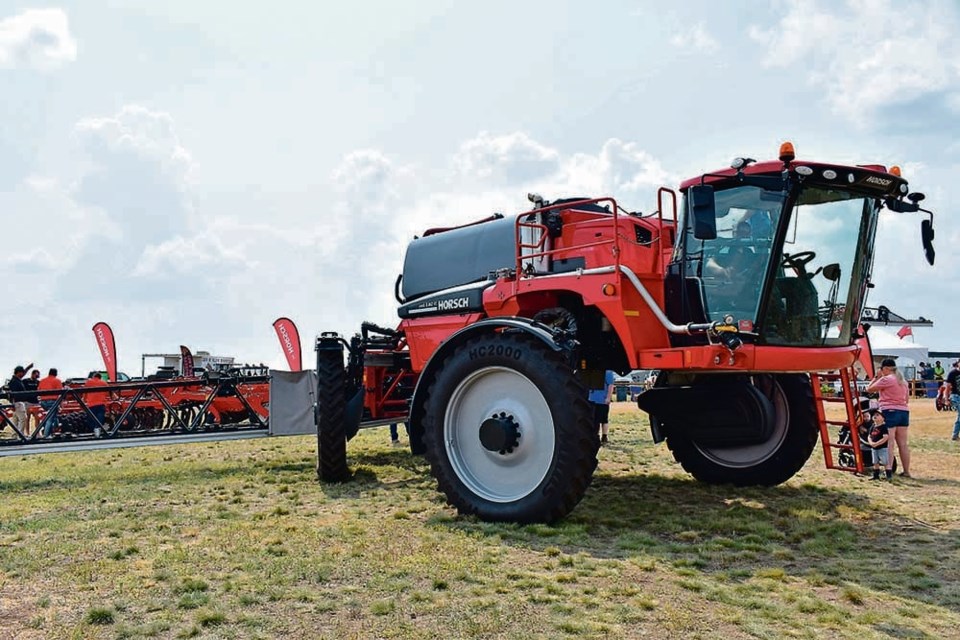LANGHAM, Sask. — European sprayer design and technology have been catching the eyes of farmers across Western Canada.
Sprayer manufacturers Agrifac and Horsch have recently expanded their markets into Canada and garnered a lot of attention. Independent sprayer consultant Tom Wolf believes the European manufacturers are ahead of the curve when it comes to innovation.
“Most of the (European) companies that are over here selling their sprayers are smaller companies, so they might be a little bit more responsive to the customer,” he said.
“They innovate constantly and can bring you their latest innovation in a very short time, whereas the larger manufacturers that we’re used to over here tend to have many years between generations of products, and might only make tiny changes between those years.”
Netherlands manufacturer Agrifac, which retails in Canada through Reesink, makes only sprayers and beet harvesters. It is independent and builds all its own technology, which allows it to adapt quickly when needed.
“The need for capacity in spraying is everywhere in crop protection,” said Rens Albers, Agrifac Condor product manager.
“The spraying window, the time when you can actually do your spraying job most efficient, where temperature’s not too high, … the moisture levels are OK (and) when the plants can effectively uptake the products is getting shorter and shorter.”
That is why the filling system, plumbing, cleanout, boom and tank size are key features on the Agrifac. It claims to have used its 160-foot Condor Endurance to spray 6,516 acres in a 24-hour span, including filling and clean out.
In a particular one-hour span, it sprayed 372 acres.
“We can only spray when it’s optimal,” said Albers, who traveled from his home in Netherlands to display the product at Ag in Motion. “How much effectiveness do you lose in your product when you’re not spraying at the right time? How much is evaporating?”
Agrifac introduced its Condor sprayer to Canada in 2014, but grew its presence when it joined with Reesink in 2019. There are now about 150 Agrifac sprayers across the Prairies.
Horsch produces more than just sprayers and introduced itself to the North American market in 2021.
Both the Agrifac and Horsch sprayers offer holding tanks up to 6,000 litres, and the Agrifac can have booms up to 180 feet with Stabilo suspension, which limits boom sway when spraying. It also allows for spray speeds up to 35 km-h.
The Horsch Leeb has booms up to 145 feet with multiple sections. Vertical-hinge sections shape the boom to the terrain, allowing booms to travel as low as 10 inches from the ground. This limits wind drift and maximizes coverage, giving more opportunity to spray on windier days and maximize coverage.
“Drift reduction. If that’s the difference between hitting the window of opportunity on your timing, you’re going to do it. You’re just going to slow the machine down,” said Horsch product manager Mike Wasylyniuk.
Stricter regulations in Europe regarding chemical waste helped push innovation for the two companies.
“There’s an opportunity for innovation,” said Wasylyniuk. “If you want to spray in Europe, there’s a certain level of regulation that the government has imposed on spraying there.
“In Western Canada, we’re kind of in the wild, wild, west for spraying where we can do whatever we want. Over there, the regulation has spurred a lot of innovation.”
Recirculating booms, nozzle improvements, improved plumbing and better clean-out are among the attributes of European sprayers.
“In particular, I think they pay better attention to two key things that matter to farmers,” said Wolf. “They have wider booms, and they have better leveling on their booms, which I think has been underperforming on some North American brands. Secondly, they pay a lot of attention to the plumbing.”
Wolf said attention to detail and customer service are attributes and representatives from the two brands listen to farmers rather than tell farmers what they need.
However, the North American warehouse and retail network is rather small, making it more difficult to acquire parts when needed. Both companies said they are selling a limited number of sprayers each year to ensure they have the parts available when needed.
“I think it’s a bit of a long road,” said Wolf. “When you have an off-brand like an Agrifac, you might have to drive 150 miles (for parts), and that’s going to limit their growth.
“I’ve been around long enough to know that it doesn’t happen overnight, but it still happens. They will continue to grow, continue to provide products farmers see value in… When we look at the space in maybe 10 years and see what’s changed, we might say ‘hey, that is significantly different.’”
You can no longer count on social media to deliver important news to you. Keep your news a touch away by bookmarking SASKTODAY.ca's homepage at this link.
Here's why you should bookmark your favourites.



